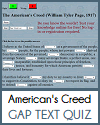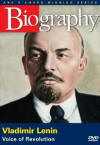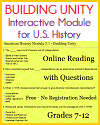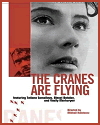Doctor Zhivago (1965)
|
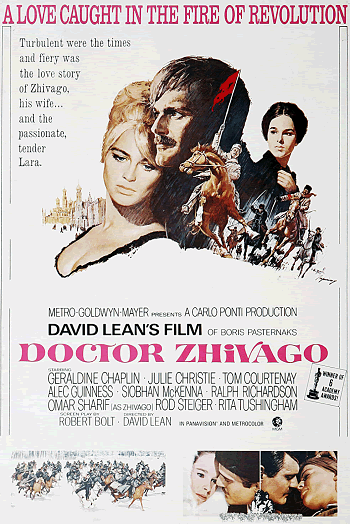 Length: 199 minutes (3 hours, 19 minutes)
Length: 199 minutes (3 hours, 19 minutes)Age appropriateness: Doctor Zhivago is officially rated "PG-13" in the United States. Its length makes it unsuitable for classroom viewing, but it is a great pick for home viewing by students studying the Russian Revolution. Creators and stars: Alec Guinness, Bernard Kay, Boris Pasternak, Carlo Ponti, David Lean, Geraldine Chaplin, Jeffrey Rockland, Julie Christie, Klaus Kinski, Lucy Westmore, Omar Sharif, Ralph Richardson, Rita Tushingham, Robert Bolt, Rod Steiger, Siobhan McKenna, Tarek Sharif, Tom Courtenay Accuracy: Doctor Zhivago is based on the Nobel Prize-winning novel of the same name by Russian writer Boris Pasternak. The gist of the screenplay is the same as the novel, though a lot of details and minor plot points are changed due to time constraints (and the film still stretches out to over three hours). References to the historical events depicted (Russian Revolution and Civil War), though characters like "Strelnikov" are fictional, are accurate. Review: David Lean's "Doctor Zhivago," winner of six Academy Awards, is one of the most popular movies of all time. The cinematography is breathtaking, the acting is excellent, and the story is riveting. "Lara's Theme" is one of the most recognizable original film scores ever written. From an educational standpoint, Doctor Zhivago brings the Russian Revolution and Civil War alive for students as it follows the lives of a group of people while these events unfold. Concepts like "socialist realism," "self-indulgent individualism," etc., can be confusing when read in a textbook. With "Doctor Zhivago," students get to see the harsh rule under the tsar, what it was like to have a home subdivided, and more. We strongly recommend giving students an overview of the Russian Revolution before watching this movie. Film timeline for historical perspective: 1903 - Death of Yuri's mother; Russia is ruled by a tsar. 1914 - Start of World War I; Pasha will serve as a soldier, Yuri as a doctor, and eventually, Lara as a volunteer nurse. 1917 - Russian Revolution under Vladimir Lenin; Russia will withdraw from World War I. 1917-1922 - Russian Civil War; Yuri, Lara, et al., spend this period in and around the fictional town of Yuriatin, east of the Ural Mountains. 1937-1938 - Great Purge under Joseph Stalin; Lara is arrested (in the novel, she later dies in a Soviet gulag, or prison camp). 1953 - "Thaw" in the Cold War following Stalin's death; this is when Yevgraf Zhivago searches for young Tonya, and remarks that Yuri Zhivago's works are no longer banned. |
Review and discussion questions: (1) How and why does Yuri come to live with the Gromeikos? (2) What happens at the street demonstration attended by Pasha (Pavel)? (3) How do Lara and Yuri first meet? (4) Describe the living arrangements of the Gromeikos in Moscow after Yuri returns from the First World War. (5) How and why does the family leave Moscow? (6) Who is Strelnikov, and why has he deserted his family? (7) What happens to the tsar and his family? (8) What happens to Yuri after he breaks things off with Lara in Yuriatin? (9) What becomes of Tonya and her children? (10) Where do Yuri and Lara go to live after Yuri deserts from the Red Army? (11) Why does Lara leave for the Far East with Komarovsky? (12) How does Yevgraf try to help Lara? (13) Under Soviet socialism, people were expected to give up their personal ambitions and desires for the good of the whole. Individual concerns were deemed unimportant. A genre of art and literature known as socialist realism reflected the goals and ideology of the Soviet government. As a poet focusing on romantic themes, Yuri Zhivago becomes "unliked" by the establishment. Compare and contrast Yuri, Yevgraf, and Pasha (Strelnikov) in terms of how they each exemplify the Soviet socialist ideal (or not). Do they pursue individual interests? Do they sacrifice personal interests for the good of the whole? Who is most interested in the health and happiness of the Russian people? Vocabulary terms and names: balalaika, Bolsheviks, civil war, comrade, counterrevolutionary, demonstration, deserters, enlist, Joseph Stalin, Mongolia, Moscow, partisan, Petrograd (a.k.a. Leningrad or St. Petersburg), rationing, reactionary, Red Army, revolution, socialism, tsar, typhus, Urals, Vladimir Lenin, Vladivostok, volunteer, White Army, World War I Click here to print a movie questions worksheet for students (PDF file). It prints as four pages, or as two double-sided sheets. It includes the timeline, terms and names, and questions. Click here to enlarge the film poster. |
 |
|---|
Doctor Zhivago Movie Review
Publication Date for Citation Purposes: June 27, 2012 |


